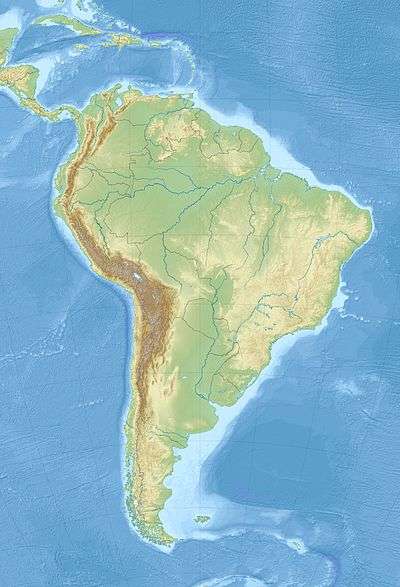Huayquerías Formation
The Huayquerías Formation (Spanish: Formación Huayquerías) is a Late Miocene fossiliferous geological formation of the Frontal Cordillera and Cuyo Basin of Argentina. The formation crops out in the central Mendoza Province.
| Huayquerías Formation Stratigraphic range: Messinian-Zanclean (defined as Huayquerian) ~6.5–5 Ma | |
|---|---|
| Type | Geological formation |
| Underlies | Tunuyán Formation |
| Thickness | Up to 126 m (413 ft) |
| Lithology | |
| Primary | Mudstone |
| Other | Sandstone, tuff |
| Location | |
| Coordinates | 33.8°S 69.0°W |
| Approximate paleocoordinates | 34.0°N 66.9°W |
| Region | Mendoza Province |
| Country | |
| Extent | Frontal Cordillera & Cuyo Basin |
| Type section | |
| Named by | Kraglievitch |
| Year defined | 1934 |
| Region | Mendoza Province |
| Country | |
 Huayquerías Formation (Argentina) | |
The formation, with a maximum thickness of 126 metres (413 ft), comprises reddish mudstones with thin beds of tuffs and sandstones, deposited in a fluvial, environment. The tuff in the formation is dated to 5.84 ± 0.41 Ma, placing it in the Montehermosan, which is significantly younger than the Huayquerian SALMA, ranging from 9 to 6.8 Ma, the age named after the formation by Kraglievitch in 1934.
The formation has provided fossils of the procyonid Cyonasua pascuali and the litoptern Huayqueriana cristata, named after the formation.
Description
The Huayqueriás Formation, present in the Frontal Cordillera and the neighboring Cuyo Basin, was described in 1934 by Kraglievitch as the basis for the Huayquerian South American land mammal age. The name Huayquerías means "badlands".[1] The formation comprises reddish mudstones with mudcracks, paleoburrows and ichnofossils of vertebrates. Thin sandstone layers of up to 12 centimetres (4.7 in) thick exist in the formation. An ashfall bed exists at 83 metres (272 ft) below the contact with the slightly angular unconformably[2] overlying Tunuyán Formation in a total section of 126 metres (413 ft).[3] The tuff has been dated using 40K/40Ar analysis to 5.84 ± 0.41 Ma.[4]
Paleontological significance
The Huayquerías Formation has been used to define the Huayquerian South American land mammal age, ranging from 9.0 to 6.8 Ma. However, later analysis of the ashfall bed in the formation, provided a much younger age of 5.84 ± 0.41 Ma, placing the formation in the Montehermosan SALMA. The Huayqueriás Formation has provided fossils of Cyonasua pascuali,[5] and the litoptern Huayqueriana cristata, named after the formation.[1]
See also
References
- Forasiepi et al., 2016, p.1
- Yrigoyen, 1993
- Garrido et al, 2017, p.51
- Marshall et al., 1986
- Linares, 1981, p.118
Bibliography
- Geology
- Garrido, Alberto C.; Ricardo Bonini, and David L. Barbeau. 2017. Paleoambiente, edad y vertebrados de la Formación Huayquerías, Mioceno Tardío, Provincia de Mendoza, Republica Argentina, 50–55. XX Congreso Geológico Argentino. Accessed 2019-03-08.
- Marshall, L.G.; Robert E. Drake, and Garniss H. Curtis. 1986. 40K-40Ar age calibration of late Miocene-Pliocene mammal-bearing Huayquerías and Tunuyán Formations, Mendoza Province, Argentina. Journal of Paleontology 60. 448–457. Accessed 2019-03-08.
- Yrigoyen, Marcelo R. 1993. Revisión estratigráfica del Neogeno de las Huayquerías de Mendoza septentrional, Argentina. Ameghiniana 31. 125–138. Accessed 2019-03-08.
- Paleontology
- Forasiepi, Analía M.; Ross D.E. MacPhee; Santiago Hernández del Pino; Gabriela I. Schmidt; Eli Amson, and Camille Grohé. 2016. Exceptional skull of Huayqueriana (Mammalia, Litopterna, Macraucheniidae) from the Late Miocene of Argentina: anatomy, systematics and paleobiological implications. Bulletin of the American Museum of Natural History 404. 1–76. Accessed 2018-10-01.
- Linares, O.J. 1981. Tres nuevos carnivoros Procionidos fósiles del Mioceno de Norte y Sudamerica. Ameghiniana 18. 113–121. Accessed 2019-03-08.
